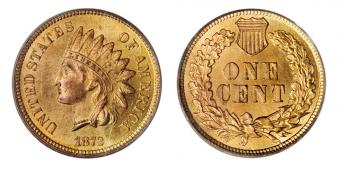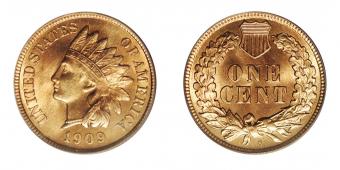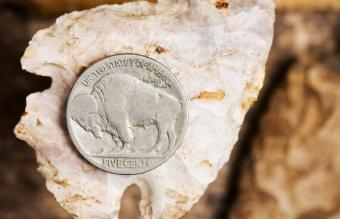
If you have some really old pennies you've inherited or found in your attic, they are definitely worth looking at in more detail. Some feature the profile of a Native American, and some of the most valuable Indian head pennies are worth thousands of dollars.
Made between 1859 and 1909, some of these coins were fairly rare even when they were first minted. Others are rare now because so few survive, especially in good condition. Some of the designs were so delicate and detailed that the intricacies of the pattern wore off quickly during circulation. A few of the rarest Indian head cents are even minting mistakes that have fascinating stories and show the human error element that's a part of minting coins.
List of the Most Valuable Indian Head Pennies
In coin collecting, value and rarity are closely linked. Some pennies are very rare in good condition, and some were rare to start out. This quick-reference chart can help you see the most valuable Indian head penny list at a glance.
| Coin | Value |
|---|---|
| 1905 Gold Indian cent | $253,000 |
| 1859 Double-headed Indian cent | $195,500 |
| 1864 L on ribbon Indian head penny | $161,000 |
| 1877 Indian head penny | $149,500 |
| 1900 Gold Indian cent | $141,000 |
| 1872 Indian head penny | $126,500 |
| 1899 Indian head penny - MS68 | $108,000 |
| 1909-S Indian head penny | $97,750 |
1905 Gold Indian Cent

There are five known Indian head cents that were struck on gold planchets (instead of copper), all dating to the early 1900s. No one knows whether these were mistakes or intentional acts to create collector coins. Ultimately, a mint worker put gold planchets or coin blanks into the coin press for pennies, resulting in these super rare coins. The strike is a little off center in this clearly different example, which sold in 2010 for $253,000.
Double-Headed 1859 Indian Head Penny

When the Indian head penny first came out in 1859, the US Mint was in the process of switching over their dies from the previous Flying Eagle cent. Along the way, a super rare double-headed Indian head cent somehow made its way out of the mint. Collectors speculate that this happened because the Flying Eagle cent had the obverse (or heads) design on the anvil, while the Indian head was on the hammer. Although many of these may have been made and destroyed after being discovered, this one example somehow slipped through and was discovered in 2000. It sold in 2008 for $195,500.
Double-headed and double-tailed coins are incredibly rare errors, with maybe only a handful existing in any denomination. While this makes your coin flips a lot fairer, it also means that if you find a coin like this, it's going to be worth a lot.
1864 L on Ribbon Indian Head Cent

Proof coins, which are rare and never enter circulation, tend to be valuable, but this super interesting example is one of the rarest. A slight redesign in 1864 sharpened the details of the portrait on the Indian head penny and put the initial of the penny's designer (L for James Longacre) on a ribbon. There are only about 20 estimated proofs for this coin, and one with very strong details and beautiful color sold for $161,000 in 2011.
1877 Indian Head Penny

Aside from the rare L on ribbon proof and serious minting errors, the 1877 Indian head cent is the one to look for. In the aftermath of the Civil War and the economic upheaval it caused, the US Mint began reissuing old pennies rather than minting new ones. This meant that the 1877 had a super low mintage of, at most, only 852,500 coins. Of these, very few survive, and even fewer survive in good condition. If you have an 1877 penny, it's worth money. One in incredible shape sold for $149,500 in 2007.
1900 Gold Indian Cent

Like the 1905 version, the 1900 gold Indian head penny is a super rare mistake that's worth a lot of money. Of the five known gold Indian head pennies, there are three from the year 1900. If you find one of these, which happened when gold planchets somehow got into the penny coin press, it's worth way more than its weight in gold. One sold for $141,000 in 2014.
1872 Indian Head Penny

Considered the second rarest Indian head penny year to try to find for your collection, the 1872 Indian cent is valuable. The same factors that made the 1877 coin rare are in play here, with very few being struck and maybe around 200 still existing in good condition. If you happen to have one, it's worth a second look. One sold for $126,500 in 2007.
1899 Indian Head Cent - MS68

Although 1899 Indian head pennies aren't always among the most valuable, this particular example is worth a lot. That's because out of the millions of Indian head cents, it's considered the best preserved coin that exists today (that's what the MS68 rating denotes). Condition is a huge factor in coin values, so if you have an Indian head penny in great shape, it is likely worth something. This particular coin sold for $108,000 in 2019.
1909-S Indian Head Penny

Almost all Indian head pennies were minted in Philadelphia and don't have a mint mark for that reason. The last two years the pennies were minted, 1908 and 1909, some of them were made in the San Francisco Mint. You can find the Indian head penny mint mark on the back of the coin under the wreath design. San Francisco coins are stamped with an S. The 1909-S Indian head penny is super rare, since the Mint was transitioning to the new Lincoln cent. One in excellent condition sold in 2006 for $97,750.
How can you tell which Indian head pennies are worth money? Look for minting errors like doubled stamps or anything out of the ordinary, as well as pennies in super good condition. The years 1877 and 1872 are important, as well as 1909-S pennies. Any Indian head penny is probably worth something, and they always merit a closer look with a magnifying glass.
Some Pennies Are Worth a Lot More Than One Cent
If you have an Indian head penny, take the time to check it over for details and condition. Finding the value of an old penny involves looking at it really carefully and taking some time to research what similar coins have sold for. Even though the face value is only one cent, it could be worth a whole lot more.







